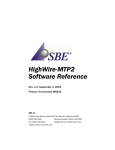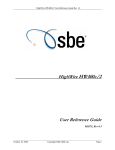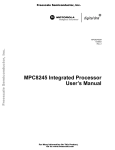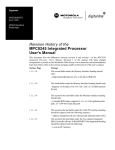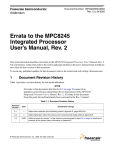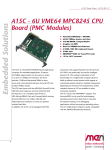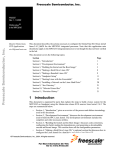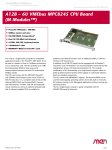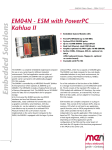Download SBE HighWire HW400c/2 Specifications
Transcript
HW400p/M A High-Performance PCI Communications Controller Technical Reference, Rev. 1.0, March 6, 2002 Primary Text Number M8239 SBE, Inc. 2305 Camino Ramon #200, San Ramon, California 94583 (925) 355-2000 Technical Support (800) 444-0990 Fax: (925) 355-2020 FaxBack Service: (800) 214-4723 Website: http://www.sbei.com Copyright ©2002 by SBE, Inc. All rights reserved. No part of this manual may be reproduced by any means without written permission from SBE, Inc., except that the purchaser may copy necessary portions for internal use only. While every effort has been made to ensure the accuracy of this manual, SBE cannot be held responsible for damage resulting from information herein. All specifications are subject to change without notice. SBE, Inc. and the SBE logo are trademarks of SBE, Inc. All other trademarks and copyrights are owned by their respective companies. About SBE, Inc. SBE, Inc., provides a broad range of intelligent communications controllers used primarily in networking systems applications. These products are sold worldwide through direct sales and distribution channels. SBE is based in San Ramon, California, and can be reached at 925-355-2000 or online at http://www.sbei.com 2 HW400p/M Technical Reference - 1.0, March 6, 2002 Contents 1. About This Manual ..................................................................................................................................... 7 1-1. Related Documents ..............................................................................................................................7 1-2. Documentation Conventions ................................................................................................................8 2. HW400p/M Introduction ........................................................................................................................... 9 2-1. Functional Components ........................................................................................................................9 3. Specifications ...........................................................................................................................................11 3-1. Processor ............................................................................................................................................ 11 Motorola MPC8245 ........................................................................................................................ 11 3-2. Memory ............................................................................................................................................... 12 Synchronous DRAM ........................................................................................................................ 12 Boot PROM ...................................................................................................................................... 12 EEPROM ........................................................................................................................................... 12 High-density Flash ........................................................................................................................... 12 3-3. I/O ....................................................................................................................................................... 13 DUART .............................................................................................................................................. 13 10/100 Mbps Ethernet/Am79C973 ............................................................................................. 13 Intel 21554 PCI-to-PCI Bridge ........................................................................................................ 13 3-4. Operating Requirements ................................................................................................................... 14 3-5. Power Requirements .......................................................................................................................... 14 3-6. Physical Characteristics ..................................................................................................................... 15 3-7. Mean Time Between Failures ............................................................................................................ 16 3-8. Compliance ......................................................................................................................................... 16 Industry standards compliance ..................................................................................................... 16 3-9. Certifications ...................................................................................................................................... 16 Safety ............................................................................................................................................... 16 Emissions ........................................................................................................................................ 16 Telecom ........................................................................................................................................... 17 Industry Canada CS03 .................................................................................................................... 18 Agency compliance ......................................................................................................................... 18 3-10. Software Support ............................................................................................................................. 19 3-11. Returns/Service ............................................................................................................................... 19 4. Functional Information ............................................................................................................................21 4-1. MPC8245 ........................................................................................................................................... 21 Development/debug support ......................................................................................................... 21 Reset ................................................................................................................................................ 21 Download and console ports ......................................................................................................... 21 4-2. PMC Site ............................................................................................................................................. 21 Compatible PMC modules .............................................................................................................. 21 Voltage keying ................................................................................................................................. 21 EMI requirements ........................................................................................................................... 22 4-3. PCI–to-PCI Bridge ............................................................................................................................... 23 HW400p/M Technical Reference - 1.0, March 6, 2002 Contents 3 PCI interface .................................................................................................................................... 23 Local PCI bus ................................................................................................................................... 23 21554 initialization without serial preload ................................................................................... 23 4-4. LEDs .................................................................................................................................................... 24 4-5. I/O Bus ................................................................................................................................................ 26 DUART .............................................................................................................................................. 26 EEPROM ........................................................................................................................................... 26 Flash ROM ....................................................................................................................................... 27 CPLD ................................................................................................................................................ 27 4-6. Panels ................................................................................................................................................. 27 4-7. I/O Bus Control and Miscellaneous Logic ........................................................................................ 28 I/O registers .................................................................................................................................... 28 Power up and reset ......................................................................................................................... 29 4-8. Connectors ......................................................................................................................................... 29 Ethernet connector ......................................................................................................................... 29 PCI connectors ................................................................................................................................ 29 4-9. COP (Common On-Chip Processor) Support ..................................................................................... 33 5. Programming Information .......................................................................................................................34 5-1. MPC8245 Memory Map .................................................................................................................... 34 Master window ................................................................................................................................ 34 8-bit peripheral devices .................................................................................................................. 34 16-bit peripheral devices ............................................................................................................... 34 Master PCI memory (MPCIM) ......................................................................................................... 34 5-2. Local PCI Address Space Map ........................................................................................................... 36 Firmware .......................................................................................................................................... 36 Masters ............................................................................................................................................ 36 Master windows .............................................................................................................................. 36 5-3. High-Density Flash ............................................................................................................................. 39 5-4. AMD Ethernet Controller Register Map ............................................................................................ 41 5-5. Intel 21554 Register Map ................................................................................................................. 41 5-6. MPC8245 Interrupt Assignments ..................................................................................................... 41 MPC8245 interrupt routing ............................................................................................................ 41 5-7. CPLD Registers ................................................................................................................................... 42 Interrupt Source Register (ISR) ...................................................................................................... 43 Interrupt Enable Register A (IERA) ................................................................................................. 44 Interrupt Enable Register B (IERB) ................................................................................................ 44 Board Status Register (BSR) .......................................................................................................... 45 LED Registers (LED) ........................................................................................................................ 46 Geographic Addressing Register (GAR) ......................................................................................... 46 Port Option Register (POR) ............................................................................................................. 47 Board Option Register (BOR) .......................................................................................................... 48 General Purpose Register (GPR) .................................................................................................... 49 4 Contents HW400p/M Technical Reference - 1.0, March 6, 2002 Figures Figure 2-1 Figure 3-1 Figure 3-2 Figure 4-1 Figure 4-2 Figure 4-3 Figure 4-4 Figure 4-5 HW400p/M functional block diagram.................................................................................................... 10 HW400p/M board layout......................................................................................................................... 11 HW400p/M dimensions .......................................................................................................................... 15 Voltage keying .......................................................................................................................................... 22 Voltage key post screw ............................................................................................................................ 22 Board LEDs ............................................................................................................................................... 25 I/O panel................................................................................................................................................... 27 COP jumpers............................................................................................................................................. 33 HW400p/M Technical Reference - 1.0, March 6, 2002 Contents 5 Tables Table 3-1 Table 3-2 Table 3-3 Table 4-1 Table 4-2 Table 4-3 Table 4-4 Table 4-5 Table 4-6 Table 4-7 Table 4-8 Table 5-1 Table 5-2 Table 5-3 Table 5-4 Table 5-5 Table 5-6 Table 5-7 Table 5-8 Table 5-9 Table 5-10 Table 5-11 Table 5-12 Table 5-13 Table 5-14 Table 5-15 Table 5-16 Operating requirements........................................................................................................................... 14 Power requirements................................................................................................................................. 14 HW400p/M physical characteristics ...................................................................................................... 15 PCI configuration access bit definitions ................................................................................................. 23 LEDs .......................................................................................................................................................... 24 EEPROM address ranges......................................................................................................................... 26 I/O registers.............................................................................................................................................. 28 Devices affected by power up and reset types ...................................................................................... 29 PCI connector P1 pin assignments ......................................................................................................... 30 MPC8245 debug connector pin assignments ....................................................................................... 32 COP header signal names ....................................................................................................................... 33 MPC8245 local address space memory map........................................................................................ 35 Masters and window access regions...................................................................................................... 36 Local PCI address space.......................................................................................................................... 38 High-density Flash.................................................................................................................................... 40 Interrupt pin functions ............................................................................................................................. 41 I/O registers.............................................................................................................................................. 42 Interrupt Source Register A – FFE20000............................................................................................... 43 Interrupt Source Register B – FFE20001............................................................................................... 43 Interrupt Enable Register A – FFE20003 ............................................................................................... 44 Interrupt Enable Register B – FFE20004............................................................................................... 44 Board Status Register – FFE20005 ....................................................................................................... 45 LED Register – FFE20006....................................................................................................................... 46 Geographic Addressing Register – FFE20008....................................................................................... 46 Port Option Register – FFE2000C .......................................................................................................... 47 Board Option Register – FFE2000D ....................................................................................................... 48 General Purpose Register—FFE2000E ................................................................................................... 49 Contents HW400p/M Technical Reference - 1.0, March 6, 2002 - 6 1. About This Manual This manual is the technical reference for the HW400p/M communications controller for the PCI bus. This manual is intended for hardware engineers who are incorporating the HW400p/M into a system. The HW400p/M Technical Reference includes: • Introduction and background on the HW400p/M communications controller and SBE, Inc. • Specifications and physical characteristics of the controller • Support information • Installation instructions • Programming information 1-1. Related Documents • PCI Local Bus Specification Rev. 2.1, June 1, 1995. • IEEE 1386-2001, Standard for a Common Mezzanine Card (CMC), Aug. 21, 2001, IEEE. • IEEE 1386.1-2001, Standard Physical and Environmental Layers for PCI Mezzanine Cards (PMC), Aug. 16, 2001, IEEE. • MPC8245 Integrated Processor User’s Manual, October 2001, Rev. 1.0. • Intel 21554 PCI-PCI Bridge Hardware Reference Manual, Sept. 1998. • AMD Am79C973/Am79C975 Single-Chip 10/100 Mbps PCI Ethernet Controller with Integrated PHY. • 3 Volt Advanced+ Boot Block Flash Memory Data Sheet, October 2001, Intel. HW400p/M Technical Reference - 1.0, March 6, 2002 Related Documents 7 1-2. Documentation Conventions Registers Register bits are numbered starting with 0. Bit 0 is the least significant and bit 7 is the most significant bit of a byte. Unless otherwise noted, register bits that are identified as “unused” do not affect the function of the register, and, if read, yield no information. Signals When referring to a signal function in text, signal names do not indicate polarity, and the / is not used. Occasionally a signal name may be followed by an asterisk (*), a pound sign (#), a # after the name, or with a / in front of the signal name. These are valid ways of indicating active low signals. Code Code is represented in Courier typeface. Placeholders Placeholders are represented in italic typeface. Throughout this manual you may find notes, cautions, and warnings that emphasize certain portions of the material presented in the text. Note: Provides information that is important to the surrounding text. Caution! 8 About This Manual Points out possible ways the product can be damaged if proper precautions are not followed. HW400p/M Technical Reference - 1.0, March 6, 2002 2. HW400p/M Introduction The HW400p/M is a member of SBE’s HighWire™ product line, a family of high-performance communications products. The HW400p/M is a network interface and protocol processing product with these characteristics: • PCI variable length form factor • A single PMC site • PCI 2.1 host interface • Architecture and software similarity with HW400 2-1. Functional Components The HW400p/M includes these functional components: • Motorola MPC8245 on-board processor • Intel 21554 PCI-PCI bridge module • 10/100base-Tx Ethernet port • PCI 2.1 host interface Figure 2-1 shows the functional block diagram for the HW400p/M. HW400p/M Technical Reference - 1.0, March 6, 2002 Functional Components 9 Figure 2-1 HW400p/M functional block diagram Development/Debug LEDs Ports Optional DUART CPLD EEPROM Flash/OTP Flash ROM NVRAM SDRAM I/O Bus and Ctrls For Development Only LEDs 10BaseT/ Am79C973 PMC Connectors 100BaseTx Ethernet Jn1 and Jn2 MPC8245 Processor Controller RJ-45 Xfrmr Local/Secondary PCI Bus 21554 PCI-to-PCI Bridge Host/Primary PCI Bus Connector 10 HW400p/M Introduction HW400p/M Technical Reference - 1.0, March 6, 2002 3. Specifications This chapter details the physical characteristics and specifications for the HW400p/M communications controller. Figure 3-1 shows the HW400p/M board layout. See Figure 2-1 for a HW400p/M functional block diagram. Figure 3-1 HW400p/M board layout RJ45 connector Debug connector Ethernet LEDS (4x) U65 J9 Dual-color U66 J8 Altera status LED CPLD EPM3256 MPC8245 AM79C973 JN2 JN1 21554 Intel PCI Bridge M2 M4 (3.3V) (5V) 3-1. Processor Motorola MPC8245 The main controller is the Motorola MPC8245, which consists of: • PowerPC 603e core operating at 333MHz • 32-bit PCI interface operating at 33MHz • SDRAM memory controller supporting SDRAMs and operating at 133MHz • General purpose I/O and ROM interface • Two-channel DMA controller • Programmable interrupt controller with multiple timers and counters HW400p/M Technical Reference - 1.0, March 6, 2002 Processor 11 3-2. Memory The HW400p/M contains a variety of memory devices for use by the MPC8245. Their characteristics are described in the following sections. Synchronous DRAM The synchronous DRAM provides the following features: • 133MHz operation • 64MB organized as a single bank of four 8M x 16 devices • No parity Boot PROM The boot PROM provides the following features: • The Flash implementation uses two byte-wide devices • PLCC devices (29LV010 or 29LV040) socketed • 3.3V LVTTL-compatible • Attached to the local I/O bus of the MPC8245 • U65 and U66 PCB reference designators (U66 is accessed by processor at power up) EEPROM The EEPROM provides the following features: • A 2k x 8 parallel device, used for the retention of manufacturing identification information • 250nsec • Attached to the local I/O bus of the MPC8245 High-density Flash Two Intel 3V Advance+ Boot Block Flash devices are used, the TE28F320C3B100A. The optional high-density Flash provides the following features: • 48-pin TSOP with an access time of 100nsec or better • 0/2/4/8 Mbytes organized as 0/512KB/1MB/2MB x 16 bits 12 Specifications HW400p/M Technical Reference - 1.0, March 6, 2002 3-3. I/O DUART 10/100 Mbps Ethernet/Am79C973 The Exar ST16C2550 Dual Universal Asynchronous Receiver/Transmitter (DUART) provides connectivity to the two serial ports via a console accessory kit. The Am79C973 controller is a single-chip 32-bit full-duplex, 10/100-Mbps fully integrated PCI-to-Wire Fast Ethernet controller. The Am79C973 controller provides the following features: • An Ethernet circuit that supports either 10BaseT or 100BaseTx • Integrates the complete 10/100 PHY interface • The internal 10/100 PHY implements Auto-Negotiation for twisted-pair (10T/100X) operating as defined in the IEEE 802.3u specification • 12k buffers • 32-bit 33MHz PCI bus interface • Four LEDS indicating the Ethernet status are surface-mounted on the board along the top edge of the PCB near RJ-45 (see Section 4-4, LEDs) • Accessible through RJ-45 (not front panel accessible) Intel 21554 PCI-to-PCI Bridge The PCI bus interface is implemented using the Intel 21554 PCI/PCI Translation Bridge chip operating at 33MHz on both the host PCI and local PCI. The PCI bus interface provides the following features: • The 21554 is a PCI master or slave for memory and I/O accesses on a 33MHz/32- or 64-bit PCI bus • 32-bit local bus • A universal signaling device that operates at 3.3V but is also 5.0-V I/Otolerant • A nontransparent PCI-to-PCI bridge that allows a local processor to independently configure and control a local subsystem HW400p/M Technical Reference - 1.0, March 6, 2002 I/O 13 3-4. Operating Requirements Table 3-1 Operating requirements Operating Requirement Caution! Acceptable Range or Value Storage temperature −40 to +85° C (−40 to 185° F) Cold start temperature 0 to 55° C (32 to 131° F) Operating temperature −5 to 55° C (23 to 131° F) (at board surface with power applied) Relative humidity 20% to 80% noncondensing Storage humidity 10% to 95% noncondensing Power requirements 13 watts maximum, without a PMC module Bring the HW400p/M communications controller to operating temperature in a noncondensing environment. The rate of change in board temperature should not exceed 2° C (35.6 °F) per minute. 3-5. Power Requirements The power requirements of the HW400p/M are 13 watts maximum, without a PMC module. Table 3-2 Power requirements 14 Specifications Voltage 5.0V Tolerance ±5% 4.75V to 5.25V Max Current 2.75A at 4.75V HW400p/M Technical Reference - 1.0, March 6, 2002 3-6. Physical Characteristics Table 3-3 provides the HW400p/M board’s parameters and dimensions. Table 3-3 HW400p/M physical characteristics Parameter Dimension Length 8.661 inches (22 cm) Height 4.25 inches (10.8 cm) Maximum component height (front) 0.570 inches (1.448 cm) Maximum component height (back) 0.105 inches (0.267 cm) Board thickness 0.062 inches ± 0.005 inches (0.157 cm ± 0.0127 cm) Figure 3-2 HW400p/M dimensions 8.661″ (22 cm) 4.25″ (10.8 cm) HW400p/M Technical Reference - 1.0, March 6, 2002 Physical Characteristics 15 3-7. Mean Time Between Failures The part failure source rate was calculated in accordance with the TELCORDIA TECHNOLOGIES Specification TR-332, version 6. This is based on an ambient temperature of 40 °C in a benign controlled environment, using Quality Level II parts. The mean time between failures for the HW400p/M is greater than or equal to 275,000 hours. 3-8. Compliance Industry standards compliance HW400p/M complies with the following industry standard specifications: • PCI Special Interest Group, “PCI Local Bus Specification,” Rev. 2.1, June 1995. • IEEE P1386 Common Mezzanine Card Standard. • IEEE P1386.1 Physical and Environmental Layers for PCI Mezzanine Cards. • GR-63-CORE, “Network Equipment-Building Systems (NEBS) Requirements: Physical Protection,” Issue 1, October 1995. 3-9. Certifications All certifications described in the following sections are pending. Safety Tested to Comply with IEC 60950:1991+A1:1992+A2:1993+A3:1995+A4:1996 (CB Report Reference No. XXXXXX - PENDING) UL 1950 Edition 3 and cUL. This adapter is a UL-listed accessory (UL File No. PENDING) and is for use only with UL-listed computers, workstations, network servers, etc. that have installation instructions that detail how to install adapter cards. Emissions EN 50082-1 and EN55022 (Report JTN PENDING). CC Part 15, Subpart B. This equipment generates, uses and can radiate radio frequency energy, and, if not installed properly and used in accordance with instructions contained in this manual, may cause harmful interference to radio communications. This device was tested and found to comply with the limits for a Class A Computing Device, in accordance with the specification in Part 15 of FCC Rules. Operation of this equipment in a residential area is likely to cause harmful interference. The user will be required to correct the interference at his or her own expense. 16 Specifications HW400p/M Technical Reference - 1.0, March 6, 2002 Telecom CTR13 (includes CTR12 and ETS 300046; −2.048 Mbit/s structured 120 ohm) (Registration No. PENDING). FCC Part 68. This device was tested and found to comply with Part 68 of FCC Rules. A label can be found on the back of the board near the RJ45 connector. This label contains the FCC Registration Number for this unit. You must, upon request, provide this information to your telephone company. FCC Registration Number PENDING USOC Jack RJ48C Note: An FCC Modular Jack is provided with this equipment. This equipment is designed to be connected to the telephone network or premises wiring using a compatible modular plug. See installation instructions, under separate cover, for details. If this equipment causes harm to the telephone network, the telephone company will notify you in advance that temporary discontinuance of service may be required. But if advance notice is not practical, the telephone company will notify the customer as soon as possible. Also, you will be advised of your right to file a complaint with the FCC if you believe it is necessary. The telephone company may make changes in its facilities, equipment, operations, or procedures that could affect the operation of the equipment. If this happens, the telephone company will provide advance notice in order for you to make the necessary modifications so as to maintain uninterrupted service. If trouble is experienced with the HW400, contact SBE, Inc., at 1-800-9252666. If the equipment is causing harm to the network, the telephone company may request you to remove the equipment from the network until the problem is resolved. Caution! No repairs are to be made by you. All repairs are made only by SBE’s USA Service Center. Unauthorized repairs void registration and warranty. Manufacturer SBE, Inc. Model name HW400p/M FCC Part 68 tests conducted by TUV Telecom 1775 Old Highway 8 NW Suites 107 & 108 St. Paul, MN 55112-1891 Report dated PENDING Report number PENDING HW400p/M Technical Reference - 1.0, March 6, 2002 Certifications 17 Industry Canada CS03 PENDING Note: The Industry Canada label identifies certified equipment. This certification means that the equipment meets telecommunications network protective, operational and safety requirements as prescribed in the appropriate Terminal Equipment Technical Requirements document(s). The Department does not guarantee the equipment will operate to the user’s satisfaction. Before installing the equipment, users should ensure that it is permissible to be connected to the facilities of the local telecommunications company. The equipment must also be installed using an accepted method of connection. The customer should be aware that compliance with the above conditions may not prevent degradation of service in some situations. Repairs to certified equipment should be coordinated by a representative designated by the supplier. Any repairs or alterations made by the user to this equipment, or any equipment malfunctions, may give the telecommunications company cause to request the user to disconnect the equipment. Caution! Agency compliance For their own protection, users should ensure that the electrical ground connections of the power utility, telephone lines and internal metallic water pipe system, if present, are connected together. This precaution may be particularly important in rural areas. Users should not attempt to make such connections themselves, but should contact the local electrical inspection authority or electrician, as appropriate. Manufacturer SBE, Inc. Model name HW400p/M CS-03 Tests conducted by TUV Telecom 1775 Old Highway 8 NW Suites 107 & 108 St. Paul, MN 55112-1891 Report dated PENDING Report number PENDING Certifications number PENDING The HW400p/M is designed to comply with the following standards or requirements: • NEBs • VCCI 18 Specifications HW400p/M Technical Reference - 1.0, March 6, 2002 3-10. Software Support Contact SBE for a list of software available for the HW400p/M communications controller. SBE website – http://www.sbei.com SBE Technical Support – 1-800-444-0990 (in North America) SBE Technical Support – +925-355-2000 (outside North America) 3-11. Returns/Service Before returning any equipment for service, you must obtain a Return Material Authorization (RMA) number from SBE. To obtain an RMA, contact SBE Customer Service: TEL: 800-925-2666 (Toll free, USA) TEL: +925-355-2000 (Outside of USA) FAX: +925-355-2020 Ship all returns to the SBE USA Service Center: SBE, Inc. 2305 Camino Ramon #200 San Ramon, CA 94583 HW400p/M Technical Reference - 1.0, March 6, 2002 Software Support 19 20 Specifications HW400p/M Technical Reference - 1.0, March 6, 2002 4. Functional Information 4-1. MPC8245 Development/debug support Reset Development and debug support is provided in the console accessory kit. A COP header is also provided on board. See Section 4-9. The following types of reset are available on the MPC8245: • Power-on reset. • Host accessible reset, which allows the host on the PCI bus to reset only the board’s local bus. • External pushbutton reset via a special SBE reset/interrupt cable on the console accessory kit. Download and console ports The console accessory kit connects to a 30-pin EBBI connector located along the top edge of the HW400p/M. The console accessory kit provides external pushbutton reset and interrupt along with download and console ports. Table 4-7 shows the pin assignments for the processor’s debug port connector. 4-2. PMC Site Compatible PMC modules Voltage keying The PMC site on the HW400p/M accepts a single wide (149mm x 74mm) module of either the PMC32 or PMC64 type. PMC64 modules operate in 32-bit mode when fitted to the HW400p/M. Both 3.3V and 5V PCI signaling modes are supported (see Voltage keying). The HW400p/M supports front panel I/O access only. Pn3/Jn3 and Pn4/Jn4 user I/O connections are not supported. PCI signaling voltage is selected using a voltage key post that mechanically prevents a signaling voltage mismatch between the module and HW400p/M. The voltage key is attached to one of two positions using a screw through the board. HW400p/M Technical Reference - 1.0, March 6, 2002 MPC8245 21 Figure 4-1 Voltage keying JN1 JN2 M2 M4 (3.3V) (5V) Figure 4-2 Voltage key post screw voltage key post Jn1/Jn2 side of PCB screw EMI requirements 22 Functional Information To ensure acceptable EMI performance, use a suitable EMI gasket on the installed PMC module. In addition, install all four mounting screws to provide proper grounding and mechanical stability. HW400p/M Technical Reference - 1.0, March 6, 2002 4-3. PCI–to-PCI Bridge PCI interface The PCI bus interface is implemented using the Intel 21554 PCI/PCI Translation Bridge chip operating at 33MHz on the backplane (PCI) and local PCI bus interface. The 21554 is a PCI master or slave for memory, and I/O accesses on a 33MHz/32- or 64-bit PCI bus. The secondary (local side) PCI bus is 32 bits in width at 33MHz. Local PCI bus The Intel 21554 provides the PCI bridge functions between the host PCI interface and local PCI bus. The 21554 supports a secondary (local side) PCI bus at a maximum operating frequency of 33MHz. The local PCI bus is 32-bit. The MPC8245 provides local PCI bus arbitration. Table 4-1 defines the PCI configuration access bits (IDSEL) used for each local PCI-capable component. Table 4-1 PCI configuration access bit definitions Local PCI IDSEL 21554 initialization without serial preload Address Bit MPC8245 REQ/GNT Ethernet Controller 16 0 PCI Bridge – 21554 17 1 PMC site 20 2 The HW400p/M does not use serial ROM to initialize the 21554. After primary reset, the 21554 terminates the serial ROM read if the first byte read does not contain the preload enable sequence. The MPC8245 must initialize the 21554 registers. Note: At power-up or PCI reset, the 21554 should be configured so that host access to the local PCI bus is disabled until the host’s configuration cycle is complete. HW400p/M Technical Reference - 1.0, March 6, 2002 PCI–to-PCI Bridge 23 4-4. LEDs A dual-color board-status LED visible from the front panel of the HW400p/M PCI is controlled by the MPC8245 via the Board Status Register (BSR) in the CPLD. See Table 4-2 for a chart of the LED functions and physical descriptions. Figure 4-3 shows the board LEDs. Table 4-2 LEDs LED Function Qty Color Description Ethernet Ethernet Link Pass LED (LAN) 1 Green Controlled by the Am79C973 Ethernet controller; indicates an active link. Ethernet Collision LED (LAN) 1 Green Controlled by the Am79C973; indicates a collision. Ethernet Active LED 1 Green Controlled by the Am79C973; indicates Ethernet activity. Ethernet 100BaseT Mode LED 2 Green Controlled by the Am79C973; indicates 100 Base-T. Power Good LED (PWR) 1 Green Indicates good power (above the minimum voltage tolerance). Can be turned off by Dark Office if desired. STATUS LED 1 Green/ Yellow (dual color) Controlled by MPC8245; visible from the front panel. 8 Green Controlled by MPC8245. Surface-mounted near the top edge of the board next to the Flash sockets. See LED Registers (LED) on page 46. General Board Status Development General Purpose LED Array 24 Functional Information HW400p/M Technical Reference - 1.0, March 6, 2002 Figure 4-3 Board LEDs E th e rn e t L E D S (4 x ) R J4 5 c o n n e c to r D e b u g c o n n e c to r Dd e v e l o p m e n t L E D s J9 D u a l-c o lo r s ta tu s L E D J8 A lte r a C P L D E P M 3 2 5 6 A M 7 9 C 9 7 3 JN 1 HW400p/M Technical Reference - 1.0, March 6, 2002 JN 2 LEDs 25 4-5. I/O Bus The I/O Bus connects the following functional elements: • DUART • EEPROM • Flash ROM • CPLD The I/O Bus has the following characteristics: • It is an 8/16-bit data bus. • It operates at 250-nsec cycle time buffered from the SDRAM bus. • It is the Port X bus from the MPC8245. DUART The DUART has two channels to support the console feature on channel B and the download feature on channel A. Each channel has a separate interrupt that is sent to the MPC8245 via the CPLD’s interrupt registers. See Section 47, I/O Bus Control and Miscellaneous Logic, for register details. Configuration, control, and data accesses are done through the DUART’s microprocessor interface. EEPROM A 2KB EEPROM organized as 2KB x 8-bit stores 1024 bytes of static factory identification information, including the board’s serial number and MAC addresses. When used with SBE’s VxWorks Boot Firmware, the remaining 1024 bytes store a boot parameter table. If the EEPROM is used for another RTOS, do not overwrite the factory information in the address ranges given in Table 4-3. Before it can be written, the EEPROM must be write-enabled by setting the EEPWEN bit in the Board Status register (BSR) of the CPLD. See Board Status Register (BSR) on page 45 for additional information. Table 4-3 EEPROM address ranges 26 Functional Information Start End Size Description 0xFFE10000 0xFFE103FF 1024 Reserved for factory use only. Do not overwrite. 0xFFE10400 0xFFE107FF 1024 Available for use by RTOS or applications code. HW400p/M Technical Reference - 1.0, March 6, 2002 Flash ROM There are two types of Flash ROM on the HW400p/M: • Two contiguous 512-kByte banks for the Boot PROM. U66 is the lower bank while U65 is the upper bank. U66 is accessed by the MPC8245 upon power up or reset. • An optional 0/2/4/8 Mbytes of high-density Flash, comprised of two Intel 3V Advance+ Boot Block Flash devices organized as 0/512KB/1MB/2MB x 16 bits. CPLD The Main CPLD generates chip selects, control signals, and read/write signals for the devices on the I/O Bus based on the address and control signals from the MPC8245. The CPLD’s internal registers also reside on the I/O Bus and are accessible by the MPC8245. See Section 4-7, I/O Bus Control and Miscellaneous Logic, for register details. 4-6. Panels Figure 4-4 shows an example of the HW400p/M I/O panel for the main board. Figure 4-4 I/O panel Dual color LED SBE HW400p/M Technical Reference - 1.0, March 6, 2002 Panels 27 4-7. I/O Bus Control and Miscellaneous Logic Two Altera CPLD on the main board provide: • Port-X I/O bus controls signals and glue logic for all devices attached to the I/O bus • Control signals that drive the front panel LEDs • General-purpose I/O registers • Reset signals I/O registers The I/O registers are accessible only by the MPC8245. Table 4-4 identifies the I/O registers. Table 4-4 I/O registers Name 28 Functional Information Description Address Function ISRA MPC8245 interrupt source register: INT [15:8] FFE20000 Read only ISRB MPC8245 interrupt source register: INT [7:0] FFE20001 Read only IERA Interrupt enable register A FFE20002 Read-write IERB Interrupt enable register B FFE20003 Read-write PCSR Port clock select FFE20004 Read-write BSR Board status register FFE20005 Read-write LED LED register FFE20006 Read-write GAR Geographic address register FFE20008 Read only POR Port Option Register FFE2000C Read only BOR Board Option Register FFE2000D Read only GPR General Purpose Register FFE2000E Read-write HW400p/M Technical Reference - 1.0, March 6, 2002 Power up and reset A microprocessor supervisory manager provides the power up reset. The device monitors both 3.3V and 2.0V levels and issues a reset if either voltage falls below its specification. The reset is active for 100ms. The reset generates other logical resets. This reset logic resides in the CPLD to provide system reset as the result of power up reset and pushbutton reset. The CPLD reset manages the various reset signals to all devices. After power up, all devices are held in a reset state for 100ms (minimum). Beyond the power up reset, all devices can be reset by the host via the PCI bus or by a pushbutton switch. Table 4-5 shows all reset types and which devices are affected. Table 4-5 Devices affected by power up and reset types Reset MPC8245 CPLD Ethernet DUART 21554 MPC8245 Pushbutton* X X X X Host PCI X X X X X Power Up X X X X X * Pushbutton reset requires the console accessory kit 4-8. Connectors Ethernet connector PCI connectors The ethernet connector is a standard RJ45 connector. It is not front panel accessible. PCI connector P1 pin assignments. Table 4-6 shows the standard PCI bus connector pin assignments for a 64-bit PCI card where the direction is with respect to the PCB. Note: The # symbol indicates an active LOW signal. HW400p/M Technical Reference - 1.0, March 6, 2002 Connectors 29 Table 4-6 PCI connector P1 pin assignments A 30 Functional Information B Pin Pin A B NC -12V 1 2 +12V NC NC GND 3 4 TDIa TDOa +5V +5V 5 6 +5V INTA# NC NC 7 8 +5V NC Reserved PRSNT1#b 9 10 V (I/O) Reserved Reserved PRSNT2#b 11 12 Keyway Keyway Keyway Keyway 13 14 Reserved Reserved RST# GND 15 16 V (I/O) CLK GNT# GND 17 18 GND REQ# Reserved V (I/O) 19 20 AD[30] AD[31] +3.3V AD[29] 21 22 AD[28] GND AD[26] AD[27] 23 24 GND AD[25] +3.3V AD[24] 25 26 IDSEL C/BE[3]# +3.3V AD[23] 27 28 AD[22] GND AD[20] AD[21] 29 30 GND AD[19] AD[18] +3.3V 31 32 AD[16] AD[17] +3.3V C/BE[2]# 33 34 FRAME# GND GND IRDY# 35 36 TRDY# +3.3V GND DEVSEL# 37 38 STOP# GND +3.3V NC 39 40 NC PERR# NC +3.3V 41 42 GND SERR# PAR +3.3V 43 44 AD[15] C/BE[1]# +3.3V AD[14] 45 46 AD[13] GND AD[11] AD[12] 47 48 GND AD[10] AP[09] M66EN 49 50 GND GND Connector Key Connector Key 51 52 C/BE[0]# AD[08] HW400p/M Technical Reference - 1.0, March 6, 2002 Table 4-6 PCI connector P1 pin assignments (continued) A B Pin Pin A B +3.3V AD[07] 53 54 AD[06] +3.3V AD[04] AD[05] 55 56 GND AD[03] AD[02] GND 57 58 AD[00] AD[01] V (I/O) V (I/O) 59 60 REQ64# ACK64# +5V +5V 61 62 +5V +5V Key way - 64-bit spacer Key way - 64-bit spacer Key way - 64-bit spacer Key way - 64-bit spacer GND Reserved 63 64 C/BE[7]# GND C/BE[5]# C/BE[6]# 65 66 V (I/O) C/BE[4]# PAR64 GND 67 68 AD[62] AD[63] GND AD[61] 69 70 AD[60] V (I/O) AD[58] AD[59] 71 72 GND AD[57] AD[56] GND 73 74 AD[54] AD[55] V (I/O) AD[53] 75 76 AD[52] GND AD[50] AD[51] 77 78 GND AD[49] AD[48] V (I/O) 79 80 AD[46] AD[47] GND AD[45] 81 82 AD[44] GND AD[42] AD[43] 83 84 V (I/O) AD[41] AD[40] GND 85 86 AD[38] AD[39] GND AD[37] 87 88 AD[36] V (I/O) AD[34] AD[35] 89 90 GND AD[33] AD[32] GND 91 92 Reserved Reserved GND Reserved 93 94 Reserved GND a. JTAG over PCI is not supported. TDO and TDI pins are shorted together on the HW400p/M. b. PRSNT1# is grounded and PRSNT2# is left floating to indicate 25W power for the HW400p/M. HW400p/M Technical Reference - 1.0, March 6, 2002 Connectors 31 MPC8245 debug connector pin assignment. Table 4-7 MPC8245 debug connector pin assignments 30-pin EBBI Connector Pins 32 Functional Information Function Direction with Respect to PCB 1 DTE TxD for Download Port Output 2 Not used 3 DTE RxD for Download Port 4 Not used 5 Not used 6 GND 7 Not used 8 Not used 9 DCE TxD for Console Port Output 10 GND Power 11 DCE RxD for Console Port Input 12 Not used 13 VCC Power 14 Reset from Pushbutton Bidirect 15 VCC Power 16 Not used 17 Not used 18 VCC 19 Not used 20 Not used 21 Not used 22 Not used 23 Push Button Interrupt Input 24 GND Power 25 Not used 26 Not used 27 GND 28 Not used 29 Not used Input 30 GND Power Input Power Power Power HW400p/M Technical Reference - 1.0, March 6, 2002 4-9. COP (Common On-Chip Processor) Support The COP function on the MPC8245 processor allows a remote computer system to access and control the internal operations of the processor. The COP interface connects to the MPC8245 via its JTAG interface through the header J8. Jumper J9 must be installed to enable the COP function. Table 4-8 shows the COP header signal names and respective pin assignments. Table 4-8 COP header signal names Pin # COP Header Signal Name Pin # COP Header Signal Name 1 TDO 2 GND 3 TDI 4 /TRST 5 VCC_3.3 (w/10K pullup) 6 VCC_3.3 (w/2K pullup) 7 TCK 8 NC 9 TMS 10 NC 11 /SRESET* 12 NC 13 /HRESET 14 NC 15 VCC_3.3 (w/10K pullup) 16 GND * The 8245 does not support /SRESET when the expanded ROM (high-density Flash) is enabled. Ensure that this pin is not asserted when expanded ROM is enabled. Figure 4-5 COP jumpers J9 J8 HW400p/M Technical Reference - 1.0, March 6, 2002 COP (Common On-Chip Processor) Support 33 5. Programming Information 5-1. MPC8245 Memory Map The MPC8245 local address space map is based on the Address Map B template presented in the MPC8245 User’s Manual. The template imposes a number of constraints on where a particular function can be located within the MPC8245 memory space. Of particular concern to the HW400p/M design is the size of the PCI master window, since both the local PCI resources and the host system memory must be accessed through this region. Master window The HW400p/M uses a 2GB master window, the largest window supported. The MPC8245 dictates that a 2GB window must reside in the upper 2GB of the MPC8245 address space, overlapping the reserved areas in the upper 48MB. These reserved areas show up as holes in the master window. That is, an access to one of the reserved areas accesses the MPC8245 defined function instead of PCI space. 8-bit peripheral devices The MPC8245 local address space map has the ability to address 8-bit peripheral devices. Access to 8-bit devices is provided via the Port-X region. To accommodate the five 8-bit devices on the HW400p/M, the 8-bit Port-X region is externally decoded into two 512KB regions and sixteen 64KB regions. The 512KB regions are used to support the HW400p/M’s PLCC flash memory devices and the 64KB regions are used to provide access to the EEPROM, DUART, and CPLD. 16-bit peripheral devices Master PCI memory (MPCIM) 34 Programming Information The MPC8245 local address space map has the ability to address 16-bit peripheral devices. Access to 16-bit devices is provided via the expanded ROM interface. The MPCIM region of the MPC8245’s address space maps 1:1 to the same region on the HW400p/M’s local PCI bus. This arrangement was chosen to simplify the overall HW400p/M design by reducing the number of address translations required. Details of what is accessible via the MPC8245 MPCIM region are contained in the HW400p/M local PCI bus address space map. See Table 5-1. HW400p/M Technical Reference - 1.0, March 6, 2002 HW400p/M Technical Reference - 1.0, March 6, 2002 Table 5-1 MPC8245 local address space memory map Start End MPC8245 Memory Map 35 Size Region 0x0000 0000 Description Reference 0x03FF FFFF 64MB CSDRAM MPC8245 SDRAM 0x0400 0000 0x77FF FFFF 1916MB RSVD Reserved 0x7800 0000 0x787F FFFF 8MB FLASH_C 0/1/4/8MB Extended Flash memory (Manufacturing option) 0x7880 0000 0x7FFF FFFF 120MB RSVD Reserved 0x8000 0000 0xFFEF FFFF 2015MB MPCIM PCI memory space master window. The CPU’s window looking out into local PCI bus memory address space. MPC8245 Integrated Processor User’s Manual 0xFC00 0000 0xFC00 0FFF 4KB EUMB MPC8245 Embedded Utilities Block. MPC8245 Integrated Processor User’s Manual 0xFC00 1000 0xFCFF FFFF 1020KB RSVD Reserved 0xFD00 0000 0xFEBF FFFF 28MB RSVD Reserved 0xFEC0 0000 0xFEDF FFFF 2MB PCI_CADDR PCI Configuration Space address register. MPC8245 Integrated Processor User’s Manual 0xFEE0 0000 0xFEEF FFFF 1MB PCI_CDAT PCI Configuration Space data register. MPC8245 Integrated Processor User’s Manual 0xFEF0 0000 0xFFDF FFFF 15MB RSVD Reserved 0xFFE0 0000 0xFFE0 FFFF 64KB DUART Exar ST16C2550 DUART registers. Console and download ports. See Download and console ports on page 21. 0xFFE1 0000 0xFFE1 FFFF 64KB EEPROM EEPROM for factory ID information. See EEPROM on page 12. 0xFFE2 0000 0xFFE2 FFFF 64KB CSREG I/O Register Module. Register access to the CPLD. See I/O registers on page 28. 0xFFE3 0000 0xFFEF FFFF 832KB RSVD Reserved 0xFFF0 0000 0xFFF7 FFFF 512KB FLASH_A PLCC-32 Flash memory socket A. Boot device. 0XFFF80000 0xFFFF FFFF 512KB FLASH_B PLCC-32 Flash memory socket B. MPC8245 Integrated Processor User’s Manual See High-density Flash on page 12. See Boot PROM on page 12. 5-2. Local PCI Address Space Map The local PCI bus address space is arbited by the MPC8245, which provides the IDSEL lines and performs the PCI configuration phase of the local PCI bus. Firmware Masters Unlike a standard PCI BIOS implementation, the MPC8245 firmware does not use a dynamic address map. The firmware uses static mapping because it knows of all possible PCI devices on the bus and their required window sizes. This simplifies the on board software by allowing static addressing to be used. Components on the installed PMC modules can be mapped within the 512MB set aside for that purpose. There are four possible masters on the local PCI bus: • MPC8245 • Am79C973 Ethernet controller • PMC site • Intel 21554 PCI-to-PCI Bridge Master windows Each master has a master window onto the bus that allows it access to specific resources. Table 5-2 shows the access regions for the individual masters. Table 5-2 Masters and window access regions Master Window Access Region MPC8245 All regions except its own memory and Configuration Space Register (CSR) registers (KMEM and KCSR regions). Ethernet controller The MPC8245’s memory, allowing it to do DMA transfers. 21554 Maps the MPC8245’s memory, or a portion thereof, and CSR registers onto the hosts PCI bus to allow the host system processor access to those memory areas. PMC All regions except its own memory space. Location rules. Two basic rules dictate the location of the main regions. First, no master can access its own resources via the PCI bus; that is, a device’s master window cannot overlap the resources it exposes to the PCI bus. Second, the base address of a master window must be a multiple of the window’s size. For example, the 2GB MPC8245 master window must start on one of the two 2GB boundaries. Host PCI bus address space. The 21554 PCI-to-PCI Bridge can map up to 1GB of primary PCI bus address space onto the local PCI bus. This space then falls within the MPC8245 master window, allowing the MPC8245 access to the host’s memory. 36 Programming Information HW400p/M Technical Reference - 1.0, March 6, 2002 This space is also accessible by the multichannel DMA controller integrated into the MPC8245. Using the DMA controller, the MPC8245 can perform DMA operation using either its own memory or any of the resources on the local PCI bus as the source or destination. Table 5-3 shows the local PCI bus address space. Note: Large portions of the PCI address space map are reserved for possible future products based on the HW400p/M main board’s modular architecture. HW400p/M Technical Reference - 1.0, March 6, 2002 Local PCI Address Space Map 37 38 Programming Information Table 5-3 Local PCI address space HW400p/M Technical Reference - 1.0, March 6, 2002 Start End Size Region Description 0x0000 0000 0x02FF FFFF 64MB KMEM MPC8245 Shared SDRAM in secondary PCI space. Also mapped into host PCI space. This is the host’s PCI bus window into the secondary PCI space. The mapping of this space onto the host PCI bus is a function of the 21554 PCI-to-PCI bridge. 0x0300 0000 0x8BFF FFFF 1472MB RSVD Reserved 0x8C00 0000 0x8C00 03FF 1KB ENET 10/100 Base T Ethernet Controller CSR registers. 0x8C00 0400 0x8C0F FFFF 2047KB RSVD Reserved 0x8C20 0000 0x8C20 0FFF 4KB PPBCSR The 21554 PCI-PCI bridge chip local configuration registers mapped into local PCI bus memory space. 0x8C20 1000 0x8C4F FFFF 1020KB RSVD Reserved 0x8C50 0000 0x9FFF FFFF 315MB RSVD Reserved 0xA000 0000 0xBFFF FFFF 512MB PMC PMC site memory space mapping area. 0xC00 00000 0xFFFF FFFF 1GB HPMWIN Host PCI bus master window. This is the MPC8245’s master window looking out onto the host PCI bus. Up to 1GB of host PCI bus address space can be mapped into the secondary PCI bus address space via the 21554 PCI-to-PCI bridge. 5-3. High-Density Flash The HW400p/M supports up to 16 Mbytes of high-density Flash via the 8245’s Expanded ROM interface. This memory utilizes a 16-bit data bus. Bits in the General Purpose Register (see General Purpose Register (GPR) on page 49) provide information about the size of each device and number of devices. Bits NVSIZ[2:0] specifies the size of each device and bit NVDEV specifies the number of devices. Table 5-4 shows the various possibilities for the high-density Flash. For a given total high-density memory size, the high-density Flash occupies a contiguous memory block (starting at 0x7800 000 in MPC8245’s local address space) regardless of the number of devices used. However when two devices are used, the device boundary must be considered during programming. The standard configuration for HW400p/M is 8Mbytes. The 64Mbit Flash device is currently unavailable, as shown in gray on the table. HW400p/M Technical Reference - 1.0, March 6, 2002 High-Density Flash 39 Table 5-4 High-density Flash Total Memory (Mbytes) Number of Devices NVDEV 1 1 0 8 Mbit, TE28F800C3BA110 000 0x7800 0000 0x780F FFFF 1 0 16 Mbit, TE28F160C3BA110 001 0x7800 0000 0x781F FFFF Device Size and Part Number NVSIZ [2:0] 8 Mbit, TE28F800C3BA110 2 2 1 000 8 Mbit, TE28F800C3BA110 1 0 2 1 1 0 16 Mbit, TE28F160C3BA110 64 Mbit, TE28F640C3BC100 2 2 1 Programming Information 0x7800 0000 0x783F FFFF 0x7800 0000 0x781F FFFF 001 011 010 0x7820 0000 0x783F FFFF 0x7800 0000 0x787F FFFF 0x7800 0000 0x783F FFFF 32 Mbit, TE28F320C3BA110 0x7840 0000 0x787F FFFF 64 Mbit, TE28F640C3BC100 0x7800 0000 0x787F FFFF 1 011 64 Mbit, TE28F640C3BC100 40 010 32 Mbit, TE28F320C3BA110 8 0x7800 0000 0x780F FFFF 0x7810 0000 0x781F FFFF 16 Mbit, TE28F160C3BA110 4 16 32 Mbit, TE28F320C3BA110 Memory Range 0x7880 0000 0x78FF FFFF HW400p/M Technical Reference - 1.0, March 6, 2002 5-4. AMD Ethernet Controller Register Map For the Am79C973 register map and further information, see the AMD Am79C973/Am79C975 PCnet-Fast III Single-Chip 10/100 Mbps PCI Ethernet Controller with Integrated PHY product manual. The URL for the AMD website is http://www.amd.com. 5-5. Intel 21554 Register Map For more information, see the Intel 21554 PCI-to-PCI Bridge for Embedded Applications Hardware Reference Manual. The URL for Intel’s website is http://www.intel.com. 5-6. MPC8245 Interrupt Assignments All interrupts are latched into an interrupt register resident in the CPLD. The CPLD generates INT0–INT4, which are read by the MPC8245 via the Epic Interrupt interface. See MPC8245 interrupt routing in Section 5-7, and the Motorola MPC8245 Integrated Processor User’s Manual Rev 1.0. MPC8245 interrupt routing The Embedded Programmable Interrupt Controller (EPIC) within the MPC8245 must be programmed to accept interrupts in discrete IRQ mode. See Table 5-5. Note: The “Active Level” column indicates the high or low active state of the interrupt as generated by the device. Table 5-5 Interrupt pin functions Pin Description Active Level INT 0 MPC8245 Pushbutton Interrupt Low to High Edge INT 1 Combined Interrupts (see Interrupt Source Register (ISR) in Section 5-7) High Active INT 2 PMC Site INTA Interrupt Low Active INT 3 Ethernet Interface Low Active INT 4 PCI bridge 21554 Low Active HW400p/M Technical Reference - 1.0, March 6, 2002 AMD Ethernet Controller Register Map 41 5-7. CPLD Registers Table 5-6 I/O registers Name 42 Programming Information Description Address Function ISRA MPC8245 interrupt source register: INT [15:8] FFE20000 Read only ISRB MPC8245 interrupt source register: INT [7:0] FFE20001 Read only IERA Interrupt enable register A FFE20002 Read-write IERB Interrupt enable register B FFE20003 Read-write PCSR Port clock select FFE20004 Read-write BSR Board status register FFE20005 Read-write LED LED register FFE20006 Read-write GAR Geographic address register FFE20008 Read only POR Port Option Register FFE2000C Read only BOR Board Option Register FFE2000D Read only GPR General Purpose Register FFE2000E Read-write HW400p/M Technical Reference - 1.0, March 6, 2002 Interrupt Source Register (ISR) The ISR is a 16-bit read-only register that is accessible by the MPC8245. The 16 interrupts are latched into this register and cleared when the interrupt has been deasserted. ISRA Interrupts. Table 5-7 shows the interrupts assigned to ISRA. Table 5-7 Interrupt Source Register A – FFE20000 Bit 7–4 Bit 3 Bit 2 Bit 1 Bit 0 Reserved INT11 INT10 INT9 INT8 Note: When any of the bits is a “1”, the corresponding interrupt is asserted. Bits 7–4 are always “0” as they are not used on this product. The ISRA interrupts are defined as: INT11 PMC Site INTD Interrupt INT10 PMC Site INTC Interrupt INT9 PMC Site INTB Interrupt INT8 PMC Site INTA Interrupt ISRB Interrupts. Table 5-8 shows the interrupts assigned to the ISRB locations 7 to 0. Table 5-8 Interrupt Source Register B – FFE20001 Bit 7–4 Bit 3 Bit 2 Bit 1–0 Reserved IRREG3 IRREG2 Reserved The ISRB interrupts are defined as: IRREG3 DUART_B Console IRREG2 DUART_A Download Note: Only INT2 and INT3 are asserted on the HW400p/M; all other bits are always 0. HW400p/M Technical Reference - 1.0, March 6, 2002 CPLD Registers 43 Interrupt Enable Register A (IERA) The Interrupt Enable Register A (IERA) contains an interrupt enable mask. The device interrupt status appears in the interrupt source registers. Setting a “1” to any of the bits enables the corresponding interrupt Table 5-9 shows the interrupts assigned to the IERA. Table 5-9 Interrupt Enable Register A – FFE20003 Bit 7–4 Bit 3 Bit 2 Bit 1 Bit 0 Reserved IE11 IE10 IE9 IE8 The IER interrupts are defined as: IE11 PMC Site INTD Interrupt IE10 PMC Site INTC Interrupt IE9 PMC Site INTB Interrupt IE8 PMC Site INTA Interrupt Note: For all: 1= Enabled, and 0 = Disabled. Interrupt Enable Register B (IERB) The Interrupt Enable Register B (IERB) is a read/write register. This register allows the MPC8245 to mask or unmask interrupts. Setting a “1” to any of the bits enables the corresponding interrupt. Table 5-10 shows the interrupts assigned to IERB. Table 5-10 Interrupt Enable Register B – FFE20004 Bit 7–4 Bit 3 Bit 2 Bit 1–0 Reserved IE3 IE2 Reserved The IERB interrupts are defined as: IE3 DUART B Interrupt IE2 DUART A Interrupt Note: For all: 1= Enabled, and 0 = Disabled 44 Programming Information HW400p/M Technical Reference - 1.0, March 6, 2002 Board Status Register (BSR) The BSR controls two board status LEDs on the panel. It also controls the Power LED. Table 5-11 shows the functions assigned to the BSR bits. Table 5-11 Board Status Register – FFE20005 Bit 7 Bit 6 Bit 5 Bit 4 Bit 3 Bit 2 Bit 1 Bit 0 Reserved FACT Reserved DARK PRTYPE EEPWEN STLEDB STLEDA The BSR functions and states are defined as: FACT 0 = Normal operating mode 1 = Factory Mode (For Factory Use Only) DARK 0 = Normal operating mode 1 = Dark Office mode (POWER LED off) PRTYPE EEPWEN 0 = MPC8245 boot PROM is flash 1 = MPC8245 boot PROM is OTP 0 = Writes to MPC8245 EEPROM are disabled 1 = Writes to MPC8245 EEPROM are enabled STLEDB 0 = Turn off Status LED B 1 = Turn on Status LED B STLEDA 0 = Turn off Status LED A 1 = Turn on Status LED A HW400p/M Technical Reference - 1.0, March 6, 2002 CPLD Registers 45 LED Registers (LED) On power up, all LEDs will be off until the LED bits are set to a 1. See Section 4-4, LEDs, for complete definitions of each LED. Writing a “1” to any LED bit turns on the corresponding LED. Table 5-12 shows the bits assigned to the LED register. Table 5-12 LED Register – FFE20006 Bit 7 Bit 6 Bit 5 Bit 4 Bit 3 Bit 2 Bit 1 Bit 0 LED_A7 LED_A6 LED_A5 LED_A4 LED_A3 LED_A2 LED_A1 LED_A0 Geographic Addressing Register (GAR) The Geographic Addressing Register (GAR) is a read-only register; all bits read as 1. The GAR will always be read as FF hex. The GAR provides compatibility with other SBE products. Table 5-13 shows the organization of the GAR 8-bit register. Table 5-13 Geographic Addressing Register – FFE20008 46 Programming Information Bit 7 Bit 6 Bit 5 Bit 4 Bit 3 Bit 2 Bit 1 Bit 0 1 1 1 1 1 1 1 1 HW400p/M Technical Reference - 1.0, March 6, 2002 Port Option Register (POR) The Port Option Register (POR) is a read-only register. This register indicates the number and type of ports in the product specific design. Table 5-14 shows the bits assigned to the POR. Table 5-14 Port Option Register – FFE2000C Bit 7 Bit 6 Bit 5 Bit 4 Bit 3 Bit 2 Bit 1 Bit 0 POR7 POR6 POR5 POR4 POR3 POR2 POR1 POR0 The POR bits and states are defined as: POR[7:0] = 00 hex 2 T1/E1/J1 ports available = 01 4 T1/E1/J1 ports available = 02 6 T1/E1/J1 ports available = 03 8 T1/E1/J1 ports available = 04 No ports = 05–FF Reserved Note: For HW400p/M, the register will always be 0x04. HW400p/M Technical Reference - 1.0, March 6, 2002 CPLD Registers 47 Board Option Register (BOR) The Board Option Register (BOR) is a read-only register. This register indicates the configuration and product type. Table 5-15 shows the bits assigned to the BOR. Table 5-15 Board Option Register – FFE2000D Bit 7 Bit 6 Bit 5 Bit 4 Bit 3 Bit 2 Bit 1 Bit 0 Reserved BUSMODE ENET RSVD TYPE3 TYPE2 TYPE1 TYPE0 The BOR bits and states are defined as: BUSMODE ENET TYPE[3:0] =0 PMC Site is incapable of performing PCI protocol =1 PMC Site is capable of performing PCI protocol =0 Ethernet circuit not present =1 Ethernet circuit is present = 0000 HW400c/R+ = 0001 HW400c/F+ = 0010 HW400p/p+ = 0011 HW400p/M other values are reserved for future products 48 Programming Information HW400p/M Technical Reference - 1.0, March 6, 2002 General Purpose Register (GPR) The General Purpose Register (GPR) is a read/write register. Bits 0 and 1 are not used. Table 5-16 shows the functions assigned to the GPR bits. Table 5-16 General Purpose Register—FFE2000E Bit 7 Bit 6 Bit 5 Bit 4 Bit 3 Bit 2 Bit 1 Bit 0 NVLCK NVSIZ2 NVSIZ1 NVSIZ0 NVDEV MPC_TYPE RSVD RSVD The GPR bits and states are defined as: NVLCK NVSIZ[2:0] =0 High-density Flash lock-down mechanism is disabled (default state) =1 High-density Flash lock-down mechanism is enabled = 000 Each high-density Flash device size is 0 Mbytes = 001 Each high-density Flash device size is 2 Mbytes = 010 Each high-density Flash device size is 4 Mbytes = 011 Each high-density Flash device size is 8 Mbytes other values are reserved for future device sizes Note: NVSIZ denotes size of each device, not the total size of the Flash. NVDEV MPC_TYP HW400p/M Technical Reference - 1.0, March 6, 2002 =0 One high-density Flash device is installed =1 Two high-density Flash devices are installed =0 8245 (hard-wired) CPLD Registers 49 50 Programming Information HW400p/M Technical Reference - 1.0, March 6, 2002


















































